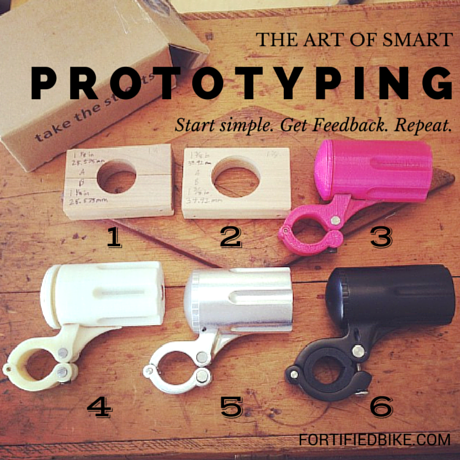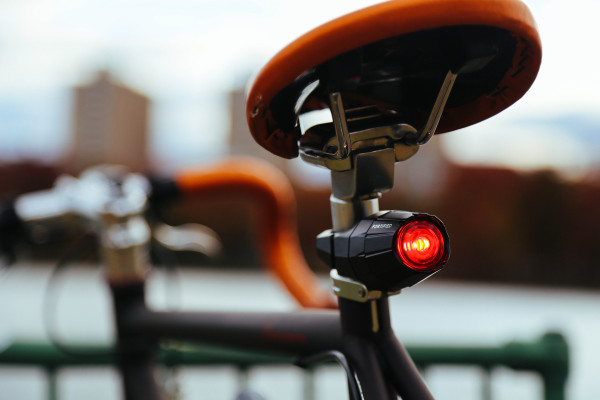
Slava Menn is a serial entrepreneur and CEO of Fortified Bicycle. He loves biking, building, entrepreneuring, and teaching. In this monthly series, he shares his team’s hard-learned startup lessons with aspiring entrepreneurs.
Last month we discussed how haters will tell you not to start a company and why you should do it anyway. Then we covered the first three lessons for launching your business:
- Turn your pain into a product idea
- Figure out if others need this product
- Do so qualitatively first (talk to people) then quantitatively (surveys)
Now that you’ve completed the first three lessons, you’re so confident the world needs your product that you start mass-producing thousands of units, right? Not so fast…
You’re about to invest upwards of $100K and one year of your life (minimum) into making this product, so you better have every detail in order. For our theft-resistant bike lights, this came down to answering the three F’s:
- Function: How should the bike light work? Should it have key to unlock it? A security screw?
- Form: What should it look like? Aggressive or unintimidating industrial design? Matte black or glossy?
- Features: How many blinking modes does it need? Should it have a built-in alarm?
Here are the steps to follow when answering these questions for your business or product idea:
Step 1: Find your MVP
In the book Lean Startup, Eric Ries teaches software entrepreneurs about the minimum viable product (MVP). For software companies, this means making the simplest version of a product in order to get immediate customer feedback. This way, if your product has any fatal flaws, you won’t have wasted precious time and money progressing down the wrong path.
In our case, we had many grandiose bike product ideas, but our simplest product was the Defender: the world’s first theft-resistant bike light. Because we started with the (relatively) simple Defender, we had the opportunity to learn about the market and our customers, allowing us to create more complex products later on.
Key Lesson: Think big and comprehensive, but start small and simple. Your learnings will be worth their weight in gold and prove invaluable when you’re ready to take on more complex products.

Step 2: Hack a cheap prototype
Whatever you build first will suck. The key is to acknowledge that it will suck and not invest too much time, money or pride into the first prototype. Instead, your goal is to iterate and only invest significant time and money once you’ve received sufficient customer feedback.
Our first two prototypes were built of wood and cost $0.30. Once we were certain they fit all handlebar sizes we produced a second prototype with a cheap 3D printer for $30. Next, we used a high precision 3D printer and built a $200 prototype. After a few final tweaks, we spent $1,000 to machine a prototype out of aluminum that we would later use for our Kickstarter project.
On our first prototype, we got a lot wrong. Had we started with machined aluminum, we would have wasted a lot of time and money.
Key Lesson: Start with a simple prototype and iterate. Then iterate, iterate and iterate some more. By rapidly iterating, we saved thousands of dollars and months of development time.
Step 3: You’re not a fighter jet, so quit being “stealth”
I’ll never forget what HubSpot Co-founder Dharmesh Shah taught when he guest-lectured at a 2010 MIT entrepreneurship class: “Stealth is for fighter jets. Share your startup with anyone who will listen.”
With each prototype you build, your goal should be get feedback from as many customers as possible. We talked to hundreds of bike shop employees, college students, and commuters about each of our prototypes and incorporated their feedback into each new model.
Now, the key to soliciting good feedback is to make it clear that you want genuine opinions, not approval, and to frame your questions accordingly. This is because many respondents will subconsciously want to please you and others will fall victim to acquiescence-bias, resulting in invalid positive feedback. If we walked up to a cyclist standing at a bike rack and said, “Don’t you hate when your light is stolen? Look what we built? Isn’t it awesome?” She may acquiesce and try to make us feel good by approving of what we were making, even if she really thought our idea sucked. Instead, ask unloaded, unbiased questions and be ready to learn from harsh feedback.
Key Lesson: Don’t go stealth with your new product. Solicit feedback from customers, but be sure to frame your questions appropriately.
Next month we’ll talk about finding awesome manufacturers who will hit the price and quality you need. In the meantime, leave your questions in the comments below or tweet at us with the #BikeStartup tag. We’ll answer every last one of them.